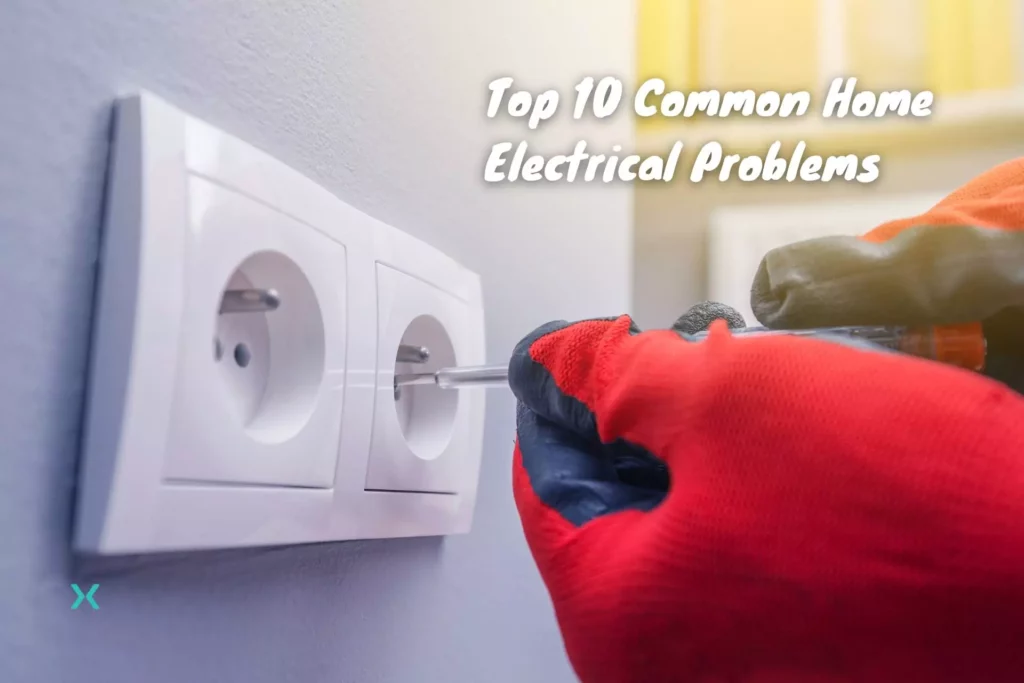Table of Contents
Every house has some electrical problems.
Here are the top 10 most common electrical problems and solutions.
🛑 STOP: When troubleshooting electrical problems, always use caution.
1. Circuit Breaker Tripping
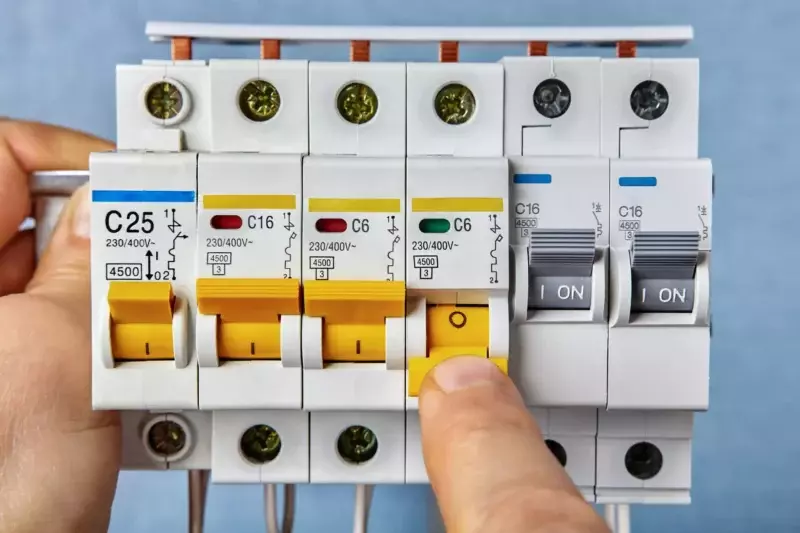
This is one of the most common electrical problems.
If a circuit breaker periodically keeps tripping, it could indicate a more serious electrical problem.
There are three common reasons for this behavior:
⚡ Overloaded Circuit
A circuit breaker is a safety switch that cuts power to the circuit when the electrical load becomes dangerously high.
The most common cause is that the circuit is overloaded.
If the circuit powers electrical appliances (such as an air conditioner), the equipment may be damaged, resulting in power surges.
Take a faulty appliance to a qualified professional.
If the circuit supplies outlets, you may have too many high-draw items plugged in, such as space heaters.
Try using a plug on a different circuit.
⚡ Short Circuit or Electrical Fault
To reset a tripped breaker, move the handle to the OFF position and then to the ON position.
If the circuit breaker trips again immediately, you likely have a short circuit or electrical fault.
Identifying the location of a short can be difficult.
If you are not experienced, it is best to contact a licensed electrician.
⚡ Worn Circuit Breakers
A circuit breaker may slowly wear out over time.
You may notice the breaker beginning to trip more often.
This possibly indicates that the breaker is worn out and needs replacement.
Replacing a circuit breaker can be dangerous.
🛑 STOP: Never open your main electrical panel if you are not experienced and qualified to do so, and be sure to cut the main breaker.
📗 Related Reading:
- Can a Circuit Breaker Fail Without Tripping? Your DIY Guide!
- Circuit Woes: When Your Electrical Breaker Keeps Tripping
2. No GFCI Outlets
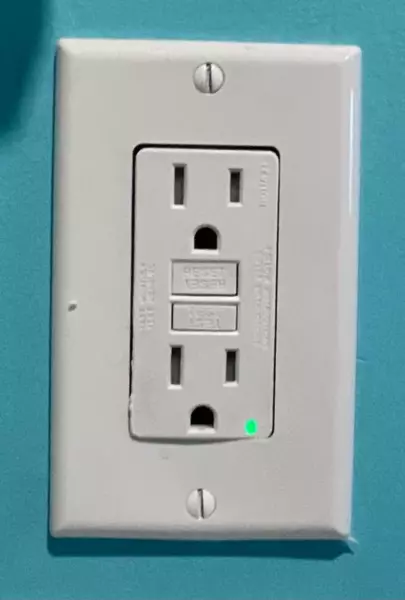
A GFCI outlet (or ground fault circuit interrupters) is required where an outlet may be exposed to water.
The GFCI outlet will detect a fault within 4 milliseconds and trip its internal breaker, possibly saving your life.
GFCI outlets are required in bathrooms and exterior outlets.
There is a risk of electrical shock if you have non-GFCI outlets in those locations.
If you have some electrical experience, installing a GFCI outlet is relatively easy, but if you have any concerns, contact a qualified electrician.
📗 Related Reading: 5 Tips For Troubleshooting GFCI Outlets
3. Aluminum Wiring
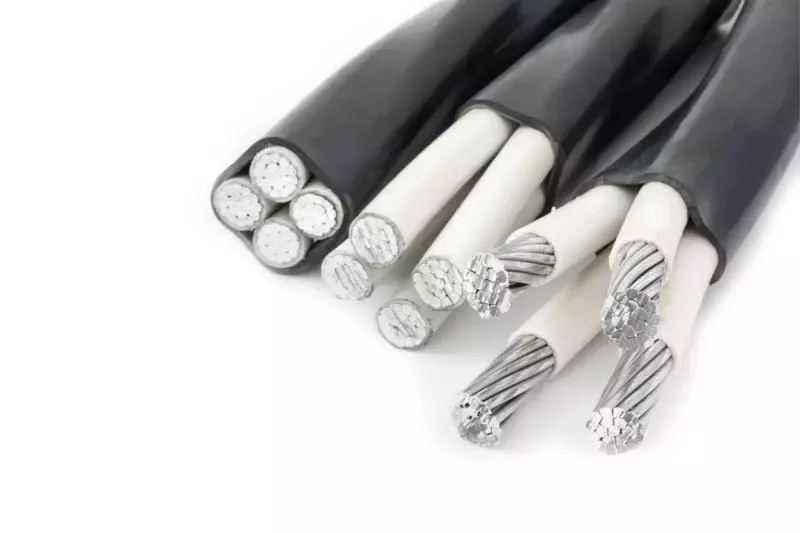
Although electrical wiring is commonly made from copper, aluminum wiring was sometimes used in the past.
Although aluminum is not considered safe, you can find it in older homes. These wiring problems pose a fire hazard.
Aluminum is susceptible to oxidation.
If a device is not designed for aluminum wiring, then the aluminum will oxidize at the point of connection.
As it oxidizes, it conducts less electricity, becoming hotter and eventually posing a fire hazard.
There are two ways to address this issue:
⚡ Replace The Wire
If the aluminum wire is bad and copper is good, then remove the aluminum and replace it with copper!
Although this is the ideal solution, it is also the most expensive due to the construction costs of repairing your walls.
This option is usually not practical unless you are gutting a house down to studs.
⚡ Splice Copper To Aluminum
The dangerous parts are at the point of connection to a device.
This is the only portion that must be replaced.
Copper wire can be spliced into the aluminum, and the copper is then connected to the device.
Of course, the same danger exists at the splice between aluminum and copper.
To mitigate this danger, use copper-to-aluminum dielectric-filled wire nuts to eliminate oxidation, allowing you to safely splice copper into aluminum.
Once this is done, and the wire is fixed, the faulty wiring is no longer an issue.
In addition to being a time-consuming process, it can be challenging to examine an entire circuit.
It is often best to contact an electrician.
📗 Related Reading: How to Deal With Aluminum Wiring In Your Home
4. Ungrounded Electrical Outlets
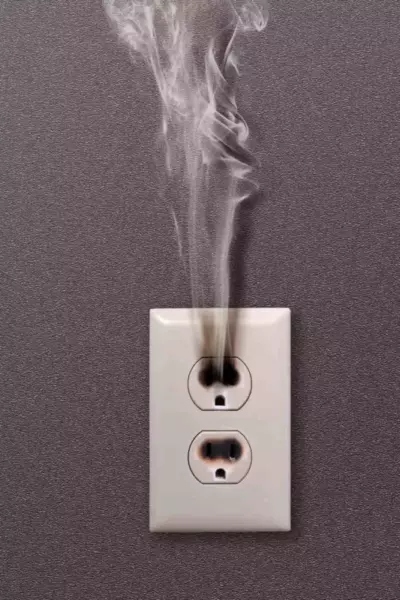
Grounding is a critical safety aspect of any electrical system.
Ungrounded outlets are one of the most common electrical issues and should be addressed immediately.
There are three common reasons why an outlet is ungrounded:
⚡ No Ground Contact
Older outlets may have two slots and no ground contact, not allowing for a three-prong plug.
In this case, the outlet must be replaced with a modern outlet.
If you have electrical experience, changing an outlet is reasonably straightforward.
⚡ Improperly Installed Outlet
The outlet may have a ground connection, but the ground wire may not be connected.
Since the outlet will look correct from the outside, use a plug tester to check if it is grounded.
If you have electrical experience, attaching the ground is pretty easy.
⚡ No Ground Wire
In older homes, some circuits may have no ground.
Without a ground, changing the outlet won’t fix the problem.
There are two possible solutions.
One is to replace the wire, which generally is impractical and cost-prohibitive.
The other option is to install a GFCI outlet.
Although you will not be able to ground the GFCI outlet, the increased sensitivity will allow it to cut power quickly in case of any faults, providing the necessary protection.
📗 Related Reading: Electrical Outlets Not Working? Here’s What You Can Do
5. Dysfunctional Switches
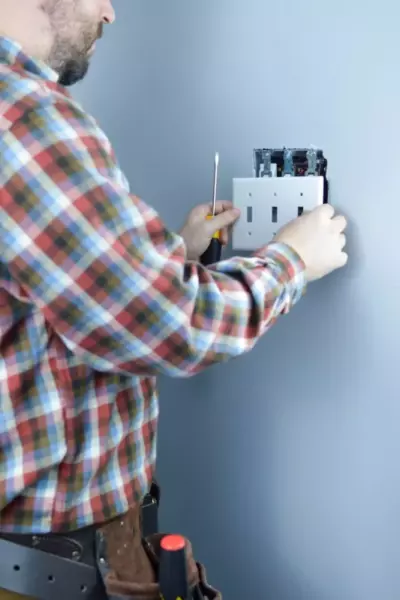
Most light switches will function for a long time, but you may find some that are not working properly.
Here are the most common problems with switches:
⚡ Loose Or Cracked Light Switch
If the outer housing is cracked, the screw terminals may be visible, exposing live wires.
Or, if the switch movement feels loose, the switch is probably worn out.
The solution is to replace the switch. Installing replacement switches is reasonably easy.
Be sure to kill the breaker and confirm the circuit is off.
⚡ Buzzing
If a switch makes a buzzing sound, it may indicate arcing within the switch.
The internal connections within the switch have probably started to wear out.
Replacing the switch is the best option. Use caution, or contact an electrician.
⚡ Dimmer Switch With Strobing Lights
A dimmer switch allows you to select bright or dim lighting.
However, you may find that with a dimmer switch, the light begins to strobe.
This behavior will appear after changing the light bulbs or fixture.
Some dimmer switches can only be used with incandescent lights.
If you replaced your incandescent bulbs with LED bulbs or an LED fixture, you must install an LED-compatible dimmer switch.
📗 Related Reading: Light Switch Not Working? Here’s How to Troubleshoot It
6. Uncovered Junction Boxes
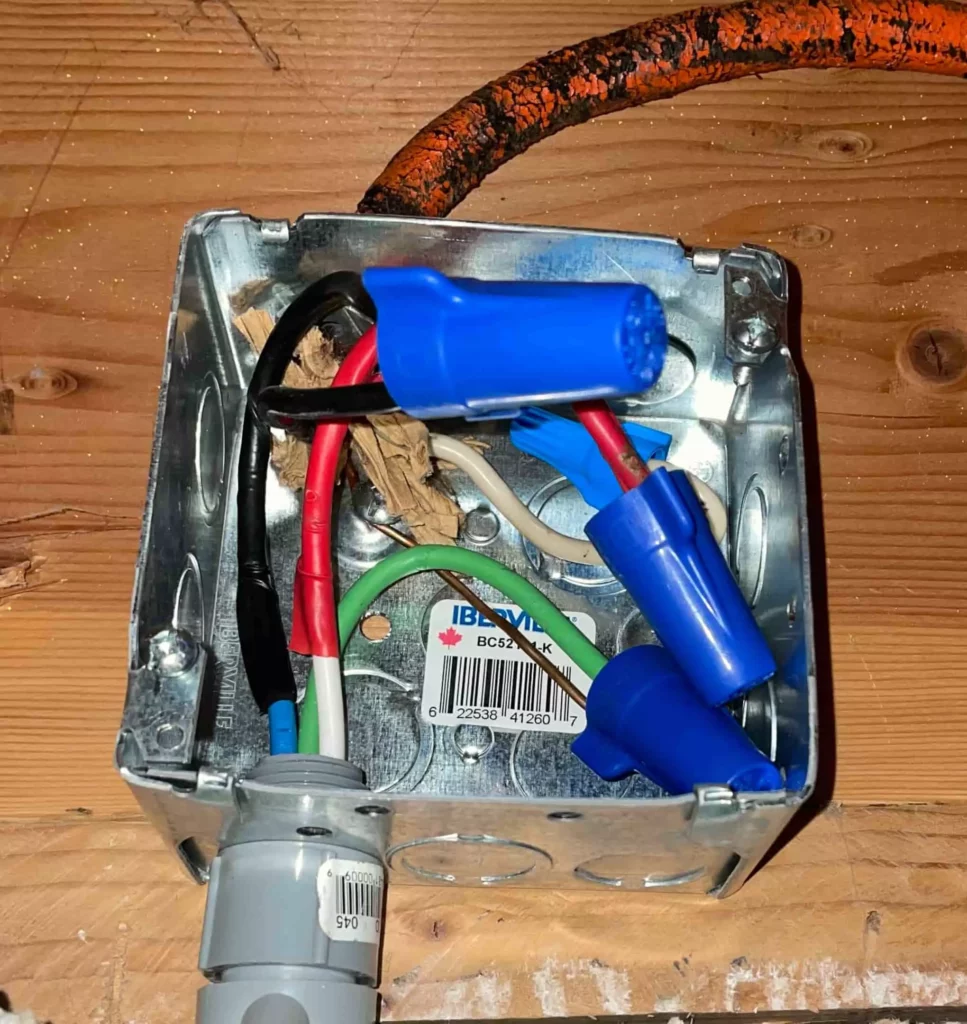
When wires are spliced, they must be housed in a junction box.
Junction boxes in your home are required to be easily accessible.
If a hot wire comes loose, this may pose a shock hazard.
The junction box is required to be grounded to protect against bad wiring, and it is essential that junction boxes have covers.
With any open junction boxes, you risk a person touching live wires.
The solution is simple.
Junction box cover plates can be purchased at any hardware store and easily installed, protecting you against these wiring problems.
7. Light Bulbs Burn Out Too Fast

Light bulbs are not built to last forever, but if you notice a light fixture that goes through bulbs quickly, it may indicate a problem.
There are a few reasons you might be burning through bulbs:
⚡ Loose Fixtures and Loose Wiring
You get voltage fluctuations if the light fixture is loose or the electrical wiring is not tight.
Either the splices to the fixture must be tighter, or the fixture must be repaired or replaced.
⚡ Light Bulb Installed Too Tightly
If a light bulb is into its light socket too tightly, the connections may not be aligned, or the connection points may have been damaged.
Try unscrewing the light bulb slightly.
⚡ Incorrect Wattage (“Over-Lamping”)
The wattage of the light bulb determines how much electrical power it will draw.
If your light bulb is a higher wattage than the wattage limit of the light fixture (known as “over-lamping”), this results in over-heating, reducing the bulb’s lifetime.
Using the correct wattage is the solution, but changing to LED lighting is also an option.
⚡ Improper Air Circulation
Another cause of overheating is that the location is too warm.
If your light is in an enclosed space with poor air circulation, this may cause the same problem.
There is also a chance of fire if the hot bulb is near combustible materials.
In a linen closet, a hot bare bulb may set fire to towels, sheets, or other combustible materials.
Changing over to LED bulbs is the easiest solution.
8. Flickering Lights On A Windy Day
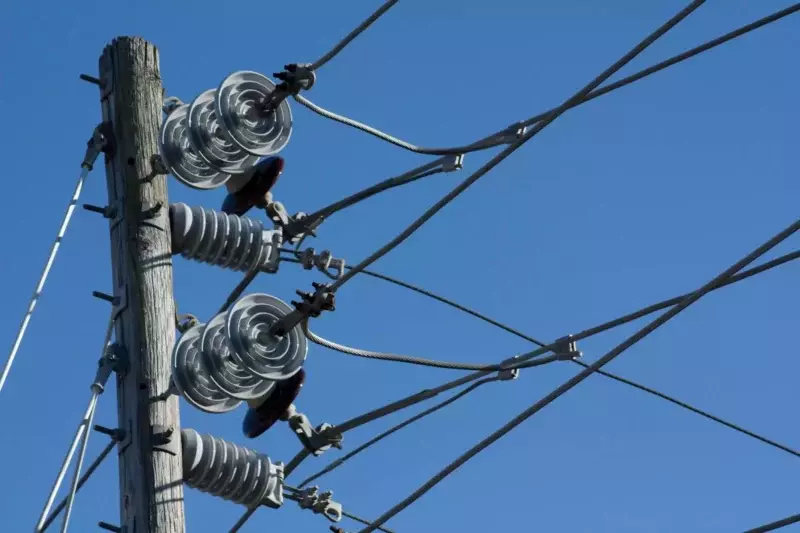
Start up your dryer, and your lights will dim momentarily.
This is the electrical load becoming unbalanced for a moment.
However, if you observe this behavior sporadically, particularly on a windy day, you may have serious electrical problems.
Dimming or flickering lights can be caused by a drop in voltage or electrical surges.
If this happens on windy days, connections to your main electrical service wires may be loose.
The loose connection may become even looser as the wires sway in the wind.
In extreme cases, you may have damaged power lines.
Contact your power supply authority or an electrician immediately.
📗 Related Reading: Lights Flickering in House? DIY Quick Fix It Guide!
9. Electrical Shocks

Electrical shocks are some of the most dangerous electrical problems.
In your home electrical system, you are protected from shocks by grounding.
Every component of the electrical system that should not be electrified must be grounded.
This includes outlet boxes, light fixtures, hard-wired equipment (such as furnaces), water and gas lines, and other electrical fixtures.
If you receive an electrical shock, the item is touching a hot wire, conducting electricity, and is not grounded.
🛑 STOP: This can be very dangerous, as a danger to people and a fire hazard.
Contact an electrician to ground the item correctly and to find any loose connections.
📗 Related Reading: Homeowners Guide to Electrical Safety
10. Loose Outlets (And Overloaded Adapters)
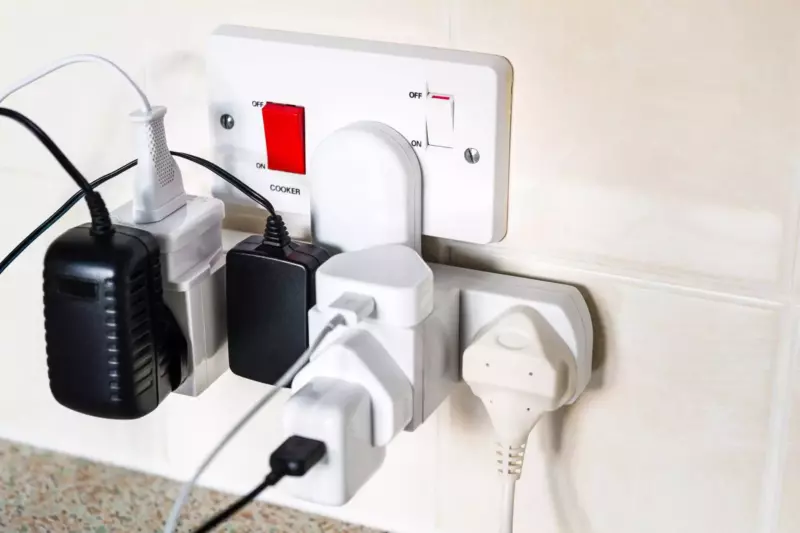
Loose outlets and overloaded adapters are some of the most common electrical problems, resulting in poor connection and possibly electrical fires.
If the plug falls out of the outlet, and the metal prongs of a plug are visible, electrical arcing may occur, people or objects may touch the prongs, and the result may be an electrical fire.
There are a few solutions to this problem.
⚡ New Outlets
Over time, the prong holes in an outlet get worn out.
The plug may no longer hold solidly.
In this case, the outlet should be replaced.
Replace the outlet with a “Tamper Resistant” outlet.
These protect children from inserting items into the outlet.
⚡ More Outlets
Outlet adapters are a convenient way to plug in more items into a single outlet.
However, using multiple adapters, or using worn-out adapters, can result in loose plugs and exposed prongs.
One solution is installing more outlets instead of loading up power strips.
⚡ Arc Fault Breakers
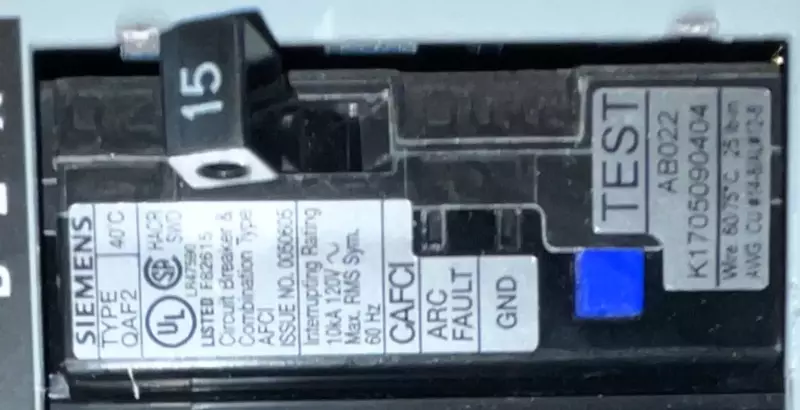
Lastly, you may want to consider upgrading your breakers to AFCI (arc fault circuit interrupter).
These single pole breakers are required in new homes but generally are not installed in older homes.
They are required in areas such as living rooms and bedrooms.
These breakers are to reduce arcing and therefore reduce electrical fires.
AFCI breakers are more sensitive than standard circuit breakers and will trip on the small sparking you might get with loose outlets.
Conclusion

Home electrical systems have many components which can fail, and every home will have some electrical problems.
With some basic information and the right electrical tools, you can diagnose electrical problems around your home.
Be careful when doing electrical work, de-energize any electrical components, use safety precautions, and contact an electrician if you have concerns.
The above list will guide you to understand some of the common electrical problems and solutions.
📗 Want to learn more about your home’s electrical system? Feel free to check out our other electrical articles!

